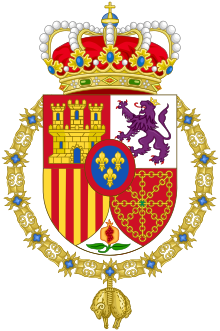Succession to the throne (Spain)
The Spanish succession to the throne is laid down in Article 57 of the Constitution of the Kingdom of Spain of December 27, 1978.
An amendment to Article 57 is considered to be a “substantial constitutional amendment” that is difficult to implement. First of all, both chambers of parliament would have to approve each with a two-thirds majority. The parliament would then be dissolved, after the new election the new parliament would again have to vote with a two-thirds majority in both chambers, after which a referendum would have to be held.
Succession to the throne
The cited constitutional provision states in the so far decisive and final paragraph 1:
- The crown of Spain is hereditary under the successors of His Majesty Don Juan Carlos I de Borbón , legitimate heir to the historical dynasty. Succession to the throne follows the rule of firstborn and substitution, the older to the younger line, the closer to the distant, preferring to the same degree the man to the woman and, if of the same sex, the older person to the younger.
According to paragraph 4 of that article, the right to the throne lapses if the person concerned marries against the express prohibition of the king and the Cortes Generales ; the loss also works against the descendants. In contrast to the Netherlands , for example , it does not require the express consent of Parliament to get married in order to maintain the line of succession, but rather a ban to exclude it.
The royal family and the leading parties have in principle agreed since the birth of Infanta Leonor that the primacy of male heirs in the line of succession should be abolished so that Leonor would be heir to the throne after her father even if she had a brother. Because of the complicated procedure, which also requires new elections, the constitutional amendment necessary for this has not yet been carried out.
According to the prevailing constitutional interpretation, the succession to the throne is not limited to the descendants of Juan Carlos I. If the ruling line of the House of Bourbon died out , an older side line could well acquire a claim to the throne. Paragraph 4 of Art. 57 is also significant in this respect, as this would allow a successor who is far from family to ascend to the throne, even if his marriage or that of his ancestors would presumably have been forbidden if the Cortes had seen the possibility of succession to the throne.
The question of whether sidelines derived from family members who had lost their claim to heir to the throne in the past are entitled to the succession has not yet been decided.
Resignations and waivers require sanctions by organic law . This also removes doubts of a legal or factual nature about the succession to the throne (Article 57, Paragraph 5).
When the ruling family died out, the Cortes made a succession plan "that best protects Spain's interests".
Illegitimate children
The Spanish Constitution does not distinguish between legitimate and illegitimate children of the king. Thus, a paternity test could establish a claim to the Spanish crown for possible illegitimate children or their descendants.
Succession list
This results in the following list of succession to the throne:
- Infanta Leonor of Spain , (born October 31, 2005), eldest daughter of the king and Letizia Ortiz Rocasolano;
- Infanta Sofía of Spain , (born April 29, 2007), second daughter of the king and Letizia Ortiz Rocasolano;
- Infanta Elena of Spain , Duchess of Lugo, (born December 20, 1963), eldest child of King Juan Carlos I;
- Felipe Juan Froilán de Todos los Santos de Marichalar y de Borbón, (born July 17, 1998), eldest child of the Duchess of Lugo;
- Victoria Federica de Marichalar y de Borbón, (born September 9, 2000), younger child of the Duchess of Lugo;
- Infanta Cristina of Spain , (born June 13, 1965), second child of King Juan Carlos I .;
- Juan Valentín de Todos los Santos Urdangarin y de Borbón, (born September 29, 1999), eldest child of Cristina of Spain;
- Pablo Nicolás Sebastian Urdangarin y de Borbón, (born December 6, 2000), second child of Cristina of Spain;
- Miguel de Todos los Santos Urdangarin y de Borbón, (born April 30, 2002), third child of Cristina of Spain;
- Irene Urdangarin y de Borbón, (born June 5, 2005), fourth child of Cristina of Spain.
Next in line to the throne would be the eldest sister of Juan Carlos, María del Pilar of Spain , Duchess of Badajoz (* July 30, 1936 - † January 8, 2020), then her four sons and a daughter. The right to succession to the throne of the Duchess of Badajoz is questionable insofar as she had waived her right to succession to the throne before her marriage, albeit not under the conditions of Article 57 (5) of the constitution, which was not yet enacted at the time. Thus, in fact, if there are no more descendants of King Juan Carlos I who are entitled to the throne, a decision by the Cortes about the succession to the throne should be required.
The other heirs to the throne would be - under the same conditions as the Duchess of Badajoz and her children - the youngest royal sister, Margarita María de Borbón , Duchess of Soria and Hernani, hereafter her two children.
See also
Individual evidence
- ^ The king's first love, Frankfurter Rundschau , August 1, 2014
